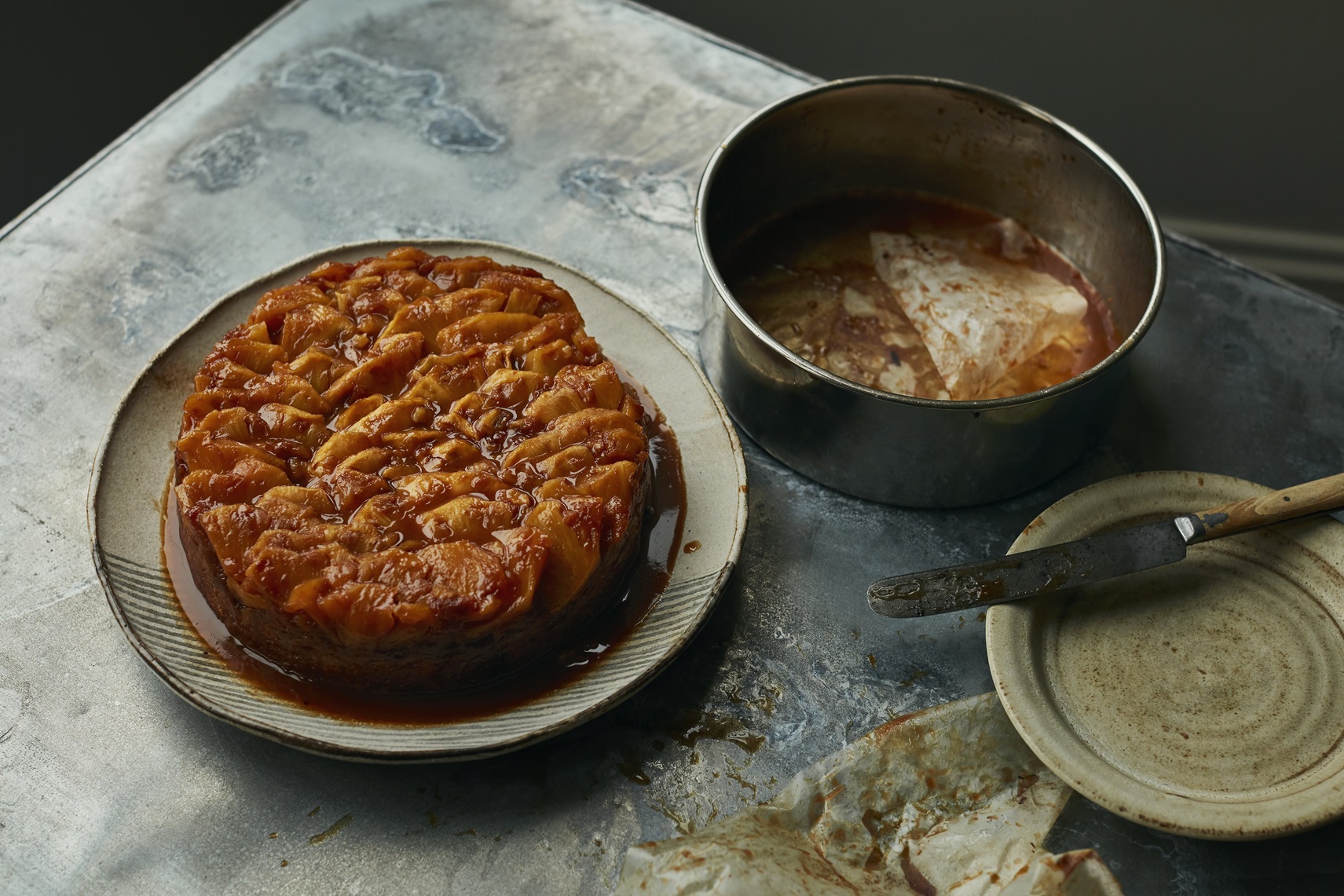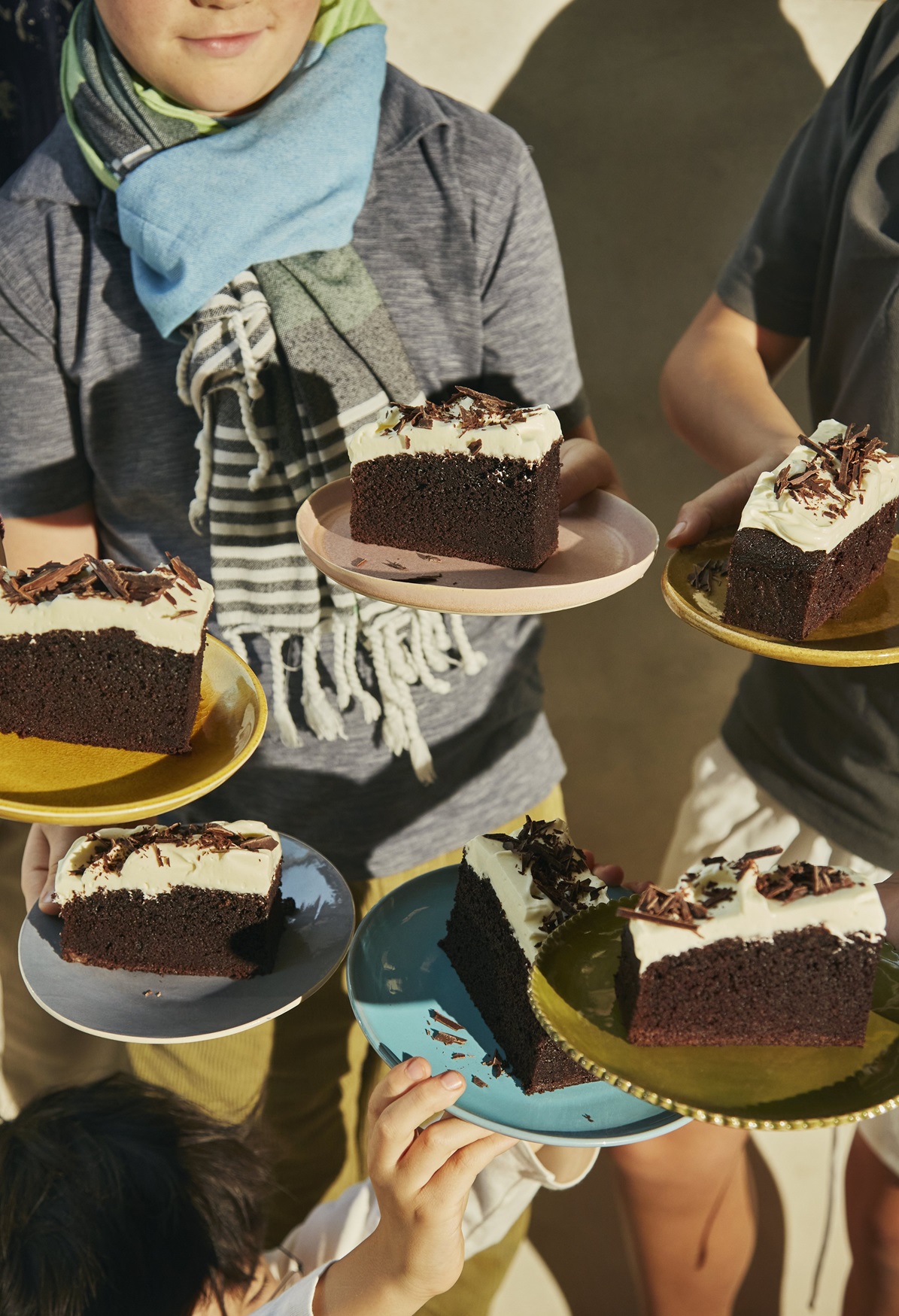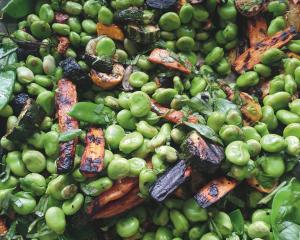
Helen Goh attempts to answer some important questions about baking in her latest book - why is baking so important in the way people signify the things that are meaningful in people’s lives and how is it that baking actually helps create meaning in our lives?
Goh, an Australian who became a pastry chef for Israeli-British chef Yotam Ottolenghi, spent a year exploring those questions through the 100 recipes she has included in her debut solo cookbook Baking and the Meaning of Life.
"You’ll find how an old-fashioned apple pie delivered to a recuperating friend, or a batch of buttery plum and pistachio bars shared at a picnic can fulfil our need to share and nurture. A lemon and labneh cake for an anniversary, a strawberry, matcha and white chocolate cream cake for a special event and a chocolate tahini cake for a birthday are a striking way to celebrate with the people we love and how how much we cherish them."
Goh was born to a Chinese family in Malaysia and moved to Australia when she was 11. She went on to study psychology at university and worked in the pharmaceutical industry.
"But I felt out of place and awkward, like I was wearing someone else’s clothes and doing someone else’s job."
Growing up, Goh’s mother cooked lots of delicious dishes, such as curries, snacks and steamed fish, but no baked goods.
"So I can’t really say why I wanted to bake. In fact, cooking of any kind was as far as could be from the kind of profession I had imagined."
Despite being aware of the sacrifices her parents had made for her to have the opportunities to go to university, Goh continued to be drawn to baking.
"Whenever I made a cake, the process absorbed me so utterly and joyously that for those moments I forgot about feeling insecure and out of place. And sharing the cake afterwards felt like my world expanded. I realised then there’s nothing twee or trivial about baking."
So when a boyfriend suggested they open a cafe, she jumped at the chance. However, even as she grew as a baker, psychology drew her back and she fell into a dual life as psychologist by day and pastry chef by night.

When she moved to London and joined Ottolenghi, developing recipes for the popular chef, she also established a counselling practice and enrolled in a doctorate.
Her studies have given her the tools to reflect on baking in a wider cultural sense, as a creative outlet and a way to to provide a sense of autonomy and satisfaction.
"After almost 30 years of studying and practising psychology, and baking professionally and privately, after publishing books and articles about bakes savoury and sweet, I’m putting on my psychological hat to explore with you the ways in which baking creates meaning as well as my chef’s toque to give you some of my most delicious recipes along the way."
So she has divided her book into chapters that reflect the way in which baking combines that sense of autonomy, competence, relatedness, beneficence and creativity that brings meaning to life from recipes to give and share, to celebrate, to nurture, to grow and to achieve.
THE BOOK
Images and text from Baking and the Meaning of Life by Helen Goh, photography by Laura Edwards. Murdoch Books RRP $59.99.
 Pineapple pudding cake with salted tamarind caramel
Pineapple pudding cake with salted tamarind caramel

The combination of pineapple, salt and tamarind was part of my childhood in Malaysia.
In fruit salads and the famous Penang laksa, the mix of sweet, tangy, salty and acidic is so vibrant and distinctive that for me it is almost synonymous with the country of my birth and, more importantly, its incredible range of foods and flavours.
Naturally, then, I wanted to re-create it in a cake. The choice of an upside-down cake was obvious when thinking about pineapple, and adding tamarind to the caramel felt like an exciting addition to the flaky sea salt we all know and love.
I have to say this is a triumphant clash of flavours, with the cake, tender and not too rich, providing just the right base to carry it all.
Serves 6-8
Tamarind caramel layer
50g unsalted butter
100g soft dark brown sugar
60g liquid tamarind concentrate (see preparation tip)
½ tsp flaky sea salt
Cake batter
160g plain flour
2 tsp baking powder
½ tsp fine sea salt
50g unsalted butter, at room temperature
150g caster sugar
finely grated zest of 2 limes
1½ tsp fennel seeds, lightly toasted, then finely ground (optional)
1 large egg, plus 1 large egg white, both at room temperature
1 tsp vanilla extract
120ml pure (double) cream, plus extra to serve
1 small pineapple, about 1kg
Method
Line the base and sides of a 20cm round cake tin (at least 5cm deep without a removable base) with baking paper. Slice and discard the top and bottom of the pineapple, then stand it on one of the ends.
Following the contours of the pineapple, remove the peel by slicing it off, from top to bottom, then quarter the pineapple lengthways. Cut away the hard central core and remove the black eyes by slicing deep V-cuts on either side of them. You should now have 4 long pieces, weighing about 600g altogether. Slice each piece thinly from the short side into small fan-shaped pieces (about mm) and place in a bowl. Set aside while you prepare the caramel.
For the caramel, combine the butter and brown sugar in a small saucepan and place over medium heat. Stir until the butter and sugar have melted and the mixture just begins to simmer. Add the tamarind concentrate and stir until combined, then allow it to come back to a simmer. Remove the pan from the heat and stir in the salt.
Carefully scrape the caramel into the prepared cake tin, then place the pineapple slices on top, overlapping them well so there are no gaps. When the entire base is covered, overlap a second layer of pineapple slices, then set the pan aside while you prepare the cake batter.
Preheat the oven to 175°C fan-forced. Sift the flour, baking powder and salt into a small bowl.
Place the butter, sugar, lime zest and fennel seeds (if using) in the bowl of an electric mixer fitted with the paddle attachment and beat on medium-high speed for 2 minutes. The mixture will be somewhat lighter, but not exactly fluffy at this stage because of the relatively small amount of butter.
Add the egg, egg white and vanilla and beat on medium speed for about 1 minute, until fully combined. Reduce the speed to low and add about one-third of the dry sifted ingredients, followed by half the cream. Mix for a few seconds to combine, then add another third of the flour and the remaining cream. Finally, incorporate the rest of the flour and mix on low speed until the batter is smooth.
Scrape the batter carefully on top of the pineapple and smooth with a small spatula to form an even top. Bake for about 50 minutes, or until the cake is lightly golden on top and a skewer inserted into the middle comes out clean.
Remove the cake from the oven and let it sit undisturbed on a wire rack for at least 30 minutes for the caramel to settle before inverting it on to a serving plate. Serve with cream on the side.
Preparation Tips
• Tamarind concentrate comes in different forms, from thick and dense to thin and watery. For this recipe, choose the Thai liquid tamarind concentrate. It is milder, sweeter and smoother in texture than the Indian style, which tends to be strongly tangy, earthy and chunkier, more suitable for curries and chutneys.
• Use a cake tin that doesn’t have a removable base so the caramel doesn’t seep out.
 Chocolate ginger beer cake
Chocolate ginger beer cake

I have always been intrigued by the fact that small children, my own included, who seem so sensitive to spice in anything else (like a healthy stir fry!), love gingerbread cookies, which have such a robust flavour profile and warm spiciness.
When the boys were going for a mega birthday sleepover, I had the idea of translating Nigella Lawson’s chocolate Guinness cake into a ginger version, replacing the Guinness with ginger beer.
It was a very successful experiment - the cake retains all the damp luxury of the original, with a backbite of ginger that engages intriguingly with the chocolate. The children loved it (and so did the adults)!
Makes 16 squares
Cake
250ml ginger beer (see preparation tip)
250g unsalted butter, sliced into about six pieces
60g unsweetened cocoa powder (preferably Dutch-processed)
250g caster sugar
130g sour cream
2 eggs
1 Tbsp vanilla extract
270g plain flour
½ tsp fine sea salt
2 tsp bicarbonate of soda
Icing
250g cream cheese, at room temperature
100g icing sugar, sifted
100ml thickened (double) cream
50ml ginger beer
flaked chocolate, to garnish
Method
Grease and line a 20cm square or round cake tin with baking paper. Preheat the oven to 160˚C fan-forced.
For the cake, combine the ginger beer and butter in a large, wide saucepan (large enough for the whole cake to be mixed in, about 3-litre capacity) and place over medium heat. Stir gently until the butter has melted. Remove from the heat and sift in the cocoa powder and sugar. Whisk to combine, then set aside to cool for 5 minutes.
Meanwhile, whisk together the sour cream, eggs and vanilla in a jug, then pour into the ginger beer mix and whisk gently to combine. Sift the flour, salt and bicarbonate of soda into the batter and whisk gently until smooth and combined. Pour the batter into the prepared tin and bake for about 55 minutes or until a skewer inserted into the centre comes out clean. Cool for 10 minutes, then remove from the tin and transfer to a wire rack to cool completely.
Meanwhile, for the icing, place the cream cheese in the bowl of an electric mixer fitted with the paddle attachment and beat on medium-low speed until smooth. Reduce the speed to low, add the icing sugar and beat for about 30 seconds, until incorporated, then add the cream and ginger beer. Increase the speed to medium and beat for 1-2 minutes, until thick and smooth. Refrigerate until needed.
When ready to serve, use a spatula to spread the icing thickly over the cake. Scatter flaked chocolate over the top, then serve.
Preparation and serving tips
• The kind of ginger beer you use will make a difference. Try a few and see which you like best. Once baked, the flavour of the ginger dissipates somewhat, so err on the side of a ginger beer with a strong presence.
• Buy the best cocoa powder you can. I like Droste, Dr Oetker or Callebaut.
• The un-iced cake will keep for about 2 days, but once iced, it’s best to eat on the same day.
 Ottolenghi lemon and labneh cake
Ottolenghi lemon and labneh cake

For the 20th anniversary of the first Ottolenghi store, we wanted to celebrate with a cake that would be quintessentially Ottolenghi. Of course, it had to be lemon!
Verena Lochmuller, my colleague and general star baker, created a true lemon extravaganza. Like Verena herself, it was no holds barred, complete with burnt lemon powder, meringue kisses, lemon marmalade, soaking syrup and dehydrated lemons.
For the full shebang, go to the Ottolenghi website or, if in London, buy a slice from the stores.
This is my simplified version. It’s still lemony and delicious, but with far fewer steps and components. Make it for afternoon tea, or as a birthday cake for a lemon lover.
Lemon curd
1 large egg, plus 2 egg yolks
90ml lemon juice
90g caster sugar
75g unsalted butter, cut into 2cm cubes
Lemon sponge
200g unsalted butter, cut into 4 chunks
270g caster sugar
1 Tbsp lemon zest (from 2 large lemons)
270g plain flour
3½ tsp baking powder
½ tsp fine sea salt
5 eggs
110g vegetable oil, or other neutral oil
110ml full-cream milk
1½ tsp vanilla extract
Sliced lemon garnish
100g caster sugar
100ml water
2 lemons, sliced into 2-3mm thin circles
Labneh mascarpone icing
300g labneh, store-bought or homemade (see preparation tip)
150g mascarpone
120g icing sugar
¾ tsp vanilla extract
1 tsp lemon juice
Method
Start by making the lemon curd, if you are not using store-bought. Using a hand whisk, whisk together the egg and yolks in a bowl and set aside. Put the lemon juice and sugar into a small saucepan and place over medium-high heat. Stir until the sugar dissolves, then, as soon as it comes to a boil, pour the syrup over the eggs, whisking the entire time.
Return the mixture to the saucepan and cook over low heat for 4-5 minutes, stirring constantly with a whisk until the mixture has thickened.
Remove from the heat and stir in the butter, one cube at a time. When all the butter has melted and the mixture is smooth, transfer the curd to a clean container and cover the surface with plastic wrap. Set aside to cool completely, then refrigerate until ready to use.
To make the sponge, first brown the butter. Put the butter in a medium saucepan and place over medium heat. Gently swirl the pan until the butter has melted, then continue to cook, swirling gently from time to time, until it is foaming. The butter will splutter and hiss quite audibly at first, then quieten down as the foam subsides and dark brown sediments begin to form on the bottom and sides of the pan. Cook for 3-5 minutes, depending on whether your stove is gas or electric. The mixture is ready when it has turned a rich golden brown and smells like toasted nuts and caramel. Remove the pan from the heat and set aside to cool to room temperature.
Grease and line the base and sides of two 20cm cake tins with baking paper. Preheat the oven to 160°C fan-forced.
Combine the sugar and lemon zest in a large bowl then, using your fingertips, rub the zest firmly into the sugar for about 1 minute, until it is tinged yellow and smells very fragrant. Sift the flour, baking powder and salt into the lemon sugar and stir to combine.
In a separate large bowl, use a hand whisk to whisk together the eggs, oil, milk and vanilla until smooth, then pour the mixture into the bowl with the dry ingredients. Using the whisk, fold together gently to incorporate the wet ingredients into the dry. Once the batter is smooth, pour in the cooled melted browned butter and whisk just to combine - don’t over mix.
Divide the batter evenly between the two cake tins (about 600g batter in each tin) and place on the middle rack of the oven. Bake for about 35 minutes, or until a skewer inserted into the centre comes out clean. Transfer the tins to a wire rack and set aside to cool.
While the cakes are cooling, make the sliced lemon garnish and the labneh mascarpone icing.
For the garnish, combine the sugar and water in a large saute pan over medium heat. Stir until the sugar dissolves, then add the lemon slices.
Cook, swirling the pan from time to time, for 6-8 minutes, until the syrup and lemons begin to colour and caramelise. Remove from the heat and use tongs to transfer the lemons on to a tray lined with baking paper.
For the icing, place the labneh, mascarpone, icing sugar, vanilla extract and lemon juice in the bowl of an electric mixer fitted with the whisk attachment and beat on low speed to begin with, then increase the speed gradually and continue to beat, scraping down the bowl and the whisk regularly, until the mix is smooth.
When ready to assemble, turn the cakes out of the tins. Measure out 100g of the lemon curd.
Place one of the cakes on a cake stand then, using a small spatula, spread a little less than half of the labneh icing over the top. Place small dollops of half the lemon curd on top, then swirl it into the labneh icing. Carefully place the second cake on top, then spread the remaining icing over the cake, repeating the swirling with the remaining lemon curd. Arrange the caramelised lemon slices on top.
Preparation tips
• The lemon curd may be store-bought, or make it from the recipe up to 3 days before filling the cake. This recipe will give you a little more than you need for this cake - the rest will be delicious spread on toast.
• If making your own labneh, start with 600g of Greek yoghurt, or 750g of regular yoghurt. Combine in a mixing bowl with tsp of fine sea salt, then scrape it into a strainer lined with a large piece of muslin or a clean tea towel, making sure the strainer doesn’t touch the bottom of the bowl. Fold the cloth over the yoghurt to cover, then leave to drain in the fridge overnight. After straining, the yoghurt will have thickened into labneh.












